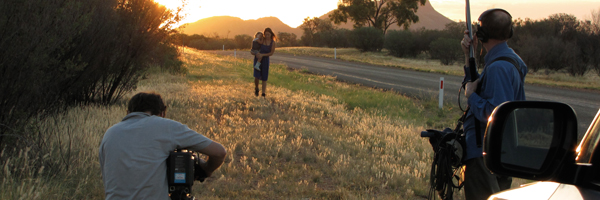Location Management: The challenge of being first in and last out
The main goal of locations management is to leave a location in a better state than you find it. The priorities are crew, location, truck, set and shot safety. With all the crew, equipment, logistics and general chaos associated with on-location filming this is a huge challenge.
Combine this with under-staffing, a lack of resources and inexperienced PAs, and this becomes an extremely stressful role, but it does come with its rewards.
Many people see locations management as the people who deal with the trash, but locations management is far more than that.
 Before getting into a more detailed discussion on locations management in general, I want to say it was a real honour working with the crew on kidnap feature American Sunset. While it took a whole crew to make this feature film work I want to make a special mention of the exceptional team work of Sean Patterson (1st AD), Nicky Despres (Production Manager), Terry Daily (Transport Co-ordinator), Roddie (Transport Captain) and especially Andre Leger (Key PA), who saved our bacon and allowed me to do many things to make this show a success. It would have otherwise been impossible and would have compromised the production.
Before getting into a more detailed discussion on locations management in general, I want to say it was a real honour working with the crew on kidnap feature American Sunset. While it took a whole crew to make this feature film work I want to make a special mention of the exceptional team work of Sean Patterson (1st AD), Nicky Despres (Production Manager), Terry Daily (Transport Co-ordinator), Roddie (Transport Captain) and especially Andre Leger (Key PA), who saved our bacon and allowed me to do many things to make this show a success. It would have otherwise been impossible and would have compromised the production.
Many people see locations management as the people who deal with the trash, but locations management is far more than that. Location Managers are always first in and last out, often together with Transport. They negotiate and prepare a location before anyone from the crew ever shows up on the day, and they attempt to make sure everything goes well logistically on the day. They are around afterwards to wrap everything and ensure the locations owners are happy with the state of the place once everything is finished.
 Good planning is fundamental. It is important to be involved as early as possible with the Director, Producer, Production Manager and Transport Co-ordinator when deciding locations, as the logistics involved can be formidable.
Good planning is fundamental. It is important to be involved as early as possible with the Director, Producer, Production Manager and Transport Co-ordinator when deciding locations, as the logistics involved can be formidable.
It is important to understand what the shots are going to be, what equipment and trucks are going to be used and where all of this equipment and trucks can be parked before you ever get to the location. The last thing you need to hear is "turning around", when you have a ten-ton truck and a couple of box vans in an intended shot.
Once a location has been chosen there are several logistical issues that need to be addressed; approval of the owners, surrounding neighbourhoods and necessary parking permits if shooting in an urban area.
On the day, the Location Manager or an experienced PA must be present to ensure that all the secured spaces are prepared prior to the arrival of trucks and equipment. It is then their responsibility to ensure all trucks and equipment are effectively positioned.
 People skills are essential. We have to liaise with the public throughout the day or night. It is paramount to have a good rapport with not only the locations owners, but everyone around the film.
People skills are essential. We have to liaise with the public throughout the day or night. It is paramount to have a good rapport with not only the locations owners, but everyone around the film.
Crew call can be 2pm, which means trucks will be arriving at 1pm or before, and the locations department may have to secure the road as early as 6am, sometimes even the prior evening, although security watches the trucks during the night if no shooting occurs.
Costs can be reduced with sufficient planning. Good PAs are hard to find as the pay is low and work is sporadic. Often PAs are cut out of a budget because it is easy to do, but it then puts a tremendous stress on the whole crew.
A perfect plan never survives contact with the enemy. The enemy, in this case, is unforeseen events.
Consider a good locations department like building a house; it is sensible to use the strongest materials as your foundation. When things don't go as planned, stress levels increase exponentially and that is when mistakes can happen and accidents occur. The Location Manager is one of the people who can call a halt to any production if safety is a concern. Traffic and set lock-ups are also controlled by the locations department, so it is essential to have PAs with the necessary experience and skills to accomplish that as safely and smoothly as possible.
Often there are multiple locations in one day. It is common to have one location being prepped, one being shot and another being wrapped, all simultaneously. It is important to have all the necessary maps prepared in advance and ensuring that all appropriate signs are up, en-route to the location. A lost key crew member costs the production and adds to stress.
A perfect plan never survives contact with the enemy. The enemy, in this case, is unforeseen events; dates, weather and even health can change. Successful adaption involves ensuring all involved are contacted, informed and agree to the changes. When booking a location, it is important to include contingencies and to know what is happening in the surrounding area.
 Once the call of "wrap" is made, the locations department needs to make sure that everything gets cleaned up safely and quickly. End of day wrap is one of the most dangerous times as everyone just wants to get out of there. Everyone wants their vehicle closest and people tend not to think about the space around them. As a result, that is when damage and injury can occur.
Once the call of "wrap" is made, the locations department needs to make sure that everything gets cleaned up safely and quickly. End of day wrap is one of the most dangerous times as everyone just wants to get out of there. Everyone wants their vehicle closest and people tend not to think about the space around them. As a result, that is when damage and injury can occur.
Once the crew has left and clean-up is finished, time is needed to ensure that everyone you have dealt with is happy with the experience and would allow another film crew in the future.
In conclusion, I have tried to cover all of the relevant points about locations management, which often gets missed and never gets a mention at awards ceremonies. It is the foundation of a successful filmmaking experience for everyone involved. Ultimately, we do empty the trash and unplug toilets, but that is a very minor part in the roles of the location department.
Images courtesy of Means of Production, Dawson Productions & Alice Springs Film And Television.
Related Posts
Comments
Not Logged in
You must be logged in to post a comment
There are 1 comments